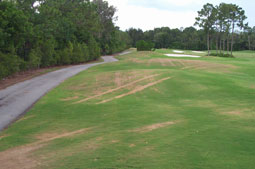Desperate Times Desperate Measures
If desperate times call for desperate measures, then these must be desperate times for some water management districts. It was mentioned recently that the Southwest Florida Water Management District will be implementing Phase III irrigation restrictions beginning in January. The supposed objective for Phase III water restrictions is a 45% reduction. As mentioned in the previous regional update, the supposed objective for Phase II restrictions was a 30% reduction, when actual irrigation allotments for many courses revealed nearly 70% reductions as compared to previous years. Many courses are quite frantic over the outcome of the upcoming Phase III restrictions and how this will affect playing conditions and turf health.
The following are my observations of the restrictions and how golf course maintenance programs in Florida are impacted:
- Phase I (15% reduction) - Most bermudagrass playing surfaces can be irrigated as necessary to provide acceptable turf quality. Roughs become off-color and localized dry spots occur at times, but no change in maintenance is necessary.
- Phase II (30% reduction) - Primary play areas (greens, tees, fairways) are kept alive and generally green in color. Regular wetting agent treatments are necessary to reduce the severity of localized dry spots. Increased mowing heights and decreased mowing frequency are necessary to improve rooting and increase the turf's ability to uptake water. Plant growth regulators also have shown some benefit in drought tolerance and can be applied on a regular basis. Cart traffic management is vital as the turf begins to lose color.
- Phase III (45% reduction) - Phase III will cause severe loss of turf color. Progression of brown conditions will begin from the outer roughs and work their way into primary playing areas. Since there is only a small percentage of water allotted as compared to previous years, greens and tees should be kept alive and the remaining water delivered to fairway landing areas when available. Healthy bermudagrass is quite drought tolerant and courses should do everything possible to maintain healthy turf conditions. In addition to the previously mentioned practices, it is important to restrict traffic as much as possible. Clubs should divert traffic away from areas that appear stressed and off-color, as the additional stress can kill turf. Eventually, it may be necessary to completely restrict cart traffic to cart paths and designated areas. Some areas may die off from drought accompanied by other stresses like shade, nematodes and traffic. These may need to be re-grassed in late spring, if irrigation restrictions are lifted at that time.
 |
|
| Cart traffic can kill turf stressed by drought |
Having an efficient irrigation system and design allows golf course superintendents to conserve water and apply it exactly where it is needed. It may be time to have your system audited by a professional irrigation consultant. If restrictions become a normal part of golf course maintenance in the future, it may also be necessary to consider decreasing irrigated bermudagrass turf acreage by installing/enlarging natural areas or utilizing drought-tolerant bahiagrass is outer rough areas.
Source: Todd Lowe, tlowe@usga.org or 941-828-2625
